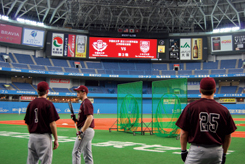Beyond the Quads
Diamond Anniversary
A nostalgic Japanese homecoming.
Back in October of 1910, the Chicago Daily Tribune reported the arrival of the University of Chicago baseball team in Japan to play Waseda University: “...twelve husky and hearty looking American lads…arrived on the N.Y.K. liner Kamakura Maru after a pleasant voyage of sixteen days” (“Maroons Received with College Yell,” Chicago Daily Tribune, Oct. 28, 1910, p. 11). The visit kicked off a series of games that continued through 1936.
The team had twice as many players and the transportation was more efficient by weeks as the Maroons arrived in Japan this spring to pick up where their predecessors left off 72 years ago, taking on Waseda University in a three-game series. A celebratory spirit set the tone for the rematch and renewal of a relationship centered on baseball.
The motivation to bring the Maroons back, says Head Coach Brian Baldea, associate chair and associate professor of physical education and athletics, “was a very important milestone in Waseda University’s history—their 125th anniversary. They consider the University of Chicago an important part of their history…and a very important part of the development of Japanese baseball in general.”
Between 1910 and 1936 the young Waseda team played the Maroons every five years, alternating between Chicago and Japan. Though the Maroons repeatedly trampled their less experienced opponents, the Waseda team learned plenty from those early matches, and over the next seven decades evolved into a baseball powerhouse.
“We played against the best competition I’ve ever played against, I think the best collegiate competition I’ve ever seen,” says senior Mike Serio, Maroon third-basemen and team co-captain. “It was quite the opportunity, and I think it really got us going for the season.”
The Maroons’ trip, sponsored primarily by Nikkan Sports News of Tokyo, was squeezed in between winter quarter exams and a six-game series in Phoenix, Arizona. The series included three exhibition games on March 23, 24, and 25 played at Hiroshima Municipal Stadium, Osaka Dome, and Seibu Dome respectively. Attendance estimates for the game at Hiroshima (the 2008 season opener for the Maroons) ranged between 10,000 and 14,000, a crowd that awed Serio, who had never played baseball before such a large gathering. Throngs of fans were just one of the signs this spring trip was extraordinary.
“What differentiated this from other overseas trips that we’ve taken is that we were guests of a university, and we were representing this history of baseball and that relationship,” says Rosalie Resch, associate chair of the athletics department, who accompanied the team to Japan. There were a number of highly emotional moments, Resch recalls, including a ceremony at the Hiroshima Peace Memorial Park adjacent to the A-bomb Dome during which the two teams lined up and presented wreaths to Hiroshima and the world. The Maroons also presented Waseda’s president, Professor Katsuhiko Shirai, with a baseball from the final game of the 1936 series played in Japan and signed by the Waseda team that year.
Along with playing the greatest college team in Japan, Baldea says, the trip was a once-in-alifetime opportunity for the players to learn about and experience the culture.
Functioning on little sleep, the team still managed to fit a bit of sightseeing into the whirlwind agenda of baseball games and special events. “It was unbelievable!” says Serio. “The cultural experience was great. The people there are so friendly….It was something I’ll never forget.”
On the way home from Japan, the Maroons stopped off in Phoenix to play six games in five days, bringing home a 4-2 record. The numbers weren’t so favorable in Japan, where the team went 0-3. However, weighed against the rich exchange of good will, sharing of cherished memories, and rekindling of an old friendship, game scores seemed a minor detail.
Says Resch, “There was so much joy for the team in this experience.”—Susan Sarver
